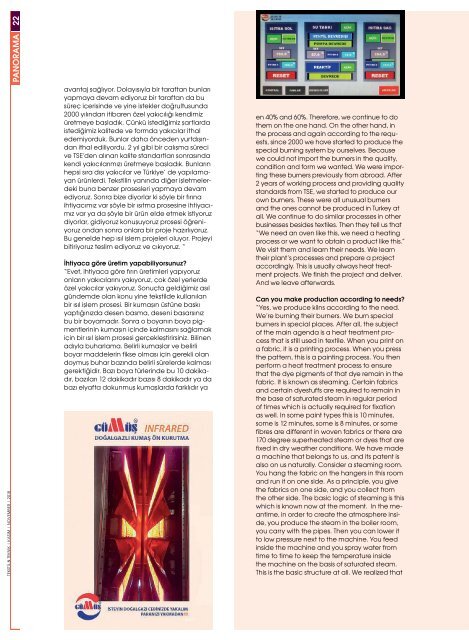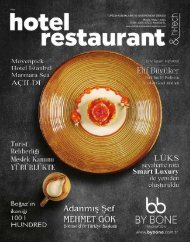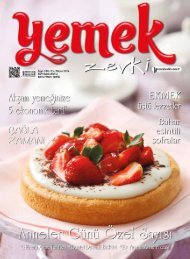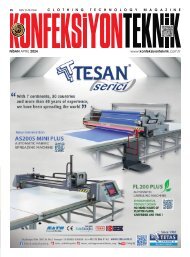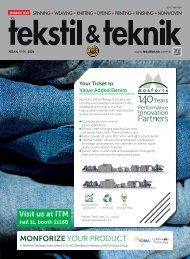You also want an ePaper? Increase the reach of your titles
YUMPU automatically turns print PDFs into web optimized ePapers that Google loves.
TEKSTİL & TEKNİK | KASIM | NOVEMBER | 2018<br />
22<br />
PANORAMA<br />
avantaj sağlıyor. Dolayısıyla bir taraftan bunları<br />
yapmaya devam ediyoruz bir taraftan da bu<br />
süreç içerisinde ve yine istekler doğrultusunda<br />
2000 yılından itibaren özel yakıcılığı kendimiz<br />
üretmeye başladık. Çünkü istediğimiz şartlarda<br />
istediğimiz kalitede ve formda yakıcılar ithal<br />
edemiyorduk. Bunlar daha önceden yurtdışından<br />
ithal ediliyordu. 2 yıl gibi bir çalışma süreci<br />
ve TSE’den alınan kalite standartları sonrasında<br />
kendi yakıcılarımızı üretmeye başladık. Bunların<br />
hepsi sıra dışı yakıcılar ve Türkiye’ de yapılamayan<br />
ürünlerdi. Tekstilin yanında diğer işletmelerdeki<br />
buna benzer prosesleri yapmaya devam<br />
ediyoruz. Sonra bize diyorlar ki şöyle bir fırına<br />
ihtiyacımız var şöyle bir ısıtma prosesine ihtiyacımız<br />
var ya da şöyle bir ürün elde etmek istiyoruz<br />
diyorlar, gidiyoruz konuşuyoruz prosesi öğreniyoruz<br />
ondan sonra onlara bir proje hazırlıyoruz.<br />
Bu genelde hep ısıl işlem projeleri oluyor. Projeyi<br />
bitiriyoruz teslim ediyoruz ve çıkıyoruz. “<br />
İhtiyaca göre üretim yapabiliyorsunuz?<br />
“Evet, ihtiyaca göre fırın üretimleri yapıyoruz<br />
onların yakıcılarını yakıyoruz, çok özel yerlerde<br />
özel yakıcılar yakıyoruz. Sonuçta geldiğimiz asıl<br />
gündemde olan konu yine tekstilde kullanılan<br />
bir ısıl işlem prosesi. Bir kumaşın üstüne baskı<br />
yaptığınızda desen basma, deseni basarsınız<br />
bu bir boyamadır. Sonra o boyanın boya pigmentlerinin<br />
kumaşın içinde kalmasını sağlamak<br />
için bir ısıl işlem prosesi gerçekleştirirsiniz. Bilinen<br />
adıyla buharlama. Belirli kumaşlar ve belirli<br />
boyar maddelerin fikse olması için gerekli olan<br />
doymuş buhar bazında belirli sürelerde kalması<br />
gerektiğidir. Bazı boya türlerinde bu 10 dakikadır,<br />
bazıları 12 dakikadır bazısı 8 dakikadır ya da<br />
bazı elyafta dokunmuş kumaşlarda farklıdır ya<br />
en 40% and 60%. Therefore, we continue to do<br />
them on the one hand. On the other hand, in<br />
the process and again according to the requests,<br />
since 2000 we have started to produce the<br />
special burning system by ourselves. Because<br />
we could not import the burners in the quality,<br />
condition and form we wanted. We were importing<br />
these burners previously from abroad. After<br />
2 years of working process and providing quality<br />
standards from TSE, we started to produce our<br />
own burners. These were all unusual burners<br />
and the ones cannot be produced in Turkey at<br />
all. We continue to do similar processes in other<br />
businesses besides textiles. Then they tell us that<br />
“We need an oven like this, we need a heating<br />
process or we want to obtain a product like this.”<br />
We visit them and learn their needs. We learn<br />
their plant’s processes and prepare a project<br />
accordingly. This is usually always heat treatment<br />
projects. We finish the project and deliver.<br />
And we leave afterwards.<br />
Can you make production according to needs?<br />
“Yes, we produce kilns according to the need.<br />
We’re burning their burners. We burn special<br />
burners in special places. After all, the subject<br />
of the main agenda is a heat treatment process<br />
that is still used in textile. When you print on<br />
a fabric, it is a printing process. When you press<br />
the pattern, this is a painting process. You then<br />
perform a heat treatment process to ensure<br />
that the dye pigments of that dye remain in the<br />
fabric. It is known as steaming. Certain fabrics<br />
and certain dyestuffs are required to remain in<br />
the base of saturated steam in regular period<br />
of times which is actually required for fixation<br />
as well. In some paint types this is 10 minutes,<br />
some is 12 minutes, some is 8 minutes, or some<br />
fibres are different in woven fabrics or there are<br />
170 degree superheated steam or dyes that are<br />
fixed in dry weather conditions. We have made<br />
a machine that belongs to us, and its patent is<br />
also on us naturally. Consider a steaming room.<br />
You hang the fabric on the hangers in this room<br />
and run it on one side. As a principle, you give<br />
the fabrics on one side, and you collect from<br />
the other side. The basic logic of steaming is this<br />
which is known now at the moment. In the meantime,<br />
in order to create the atmosphere inside,<br />
you produce the steam in the boiler room,<br />
you carry with the pipes. Then you can lower it<br />
to low pressure next to the machine. You feed<br />
inside the machine and you spray water from<br />
time to time to keep the temperature inside<br />
the machine on the basis of saturated steam.<br />
This is the basic structure at all. We realized that


